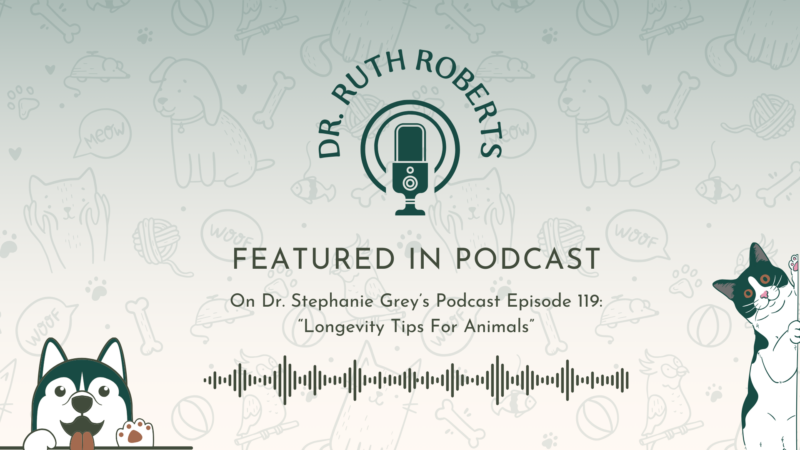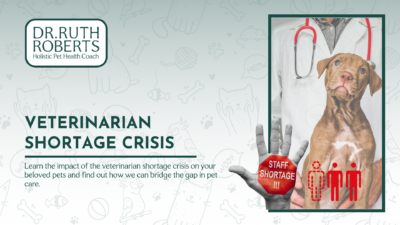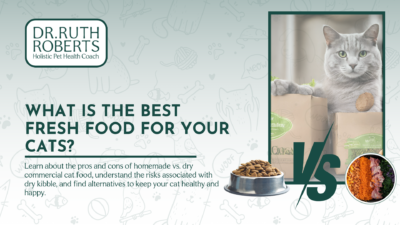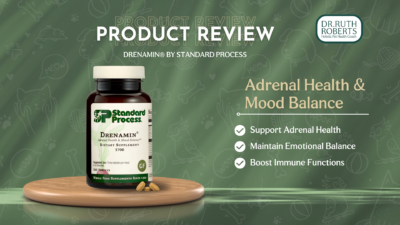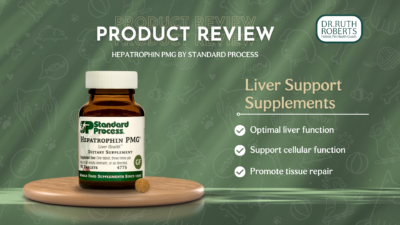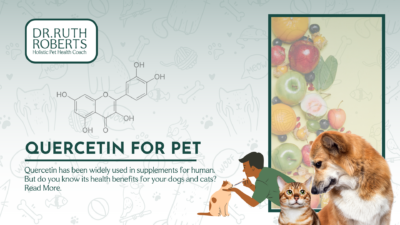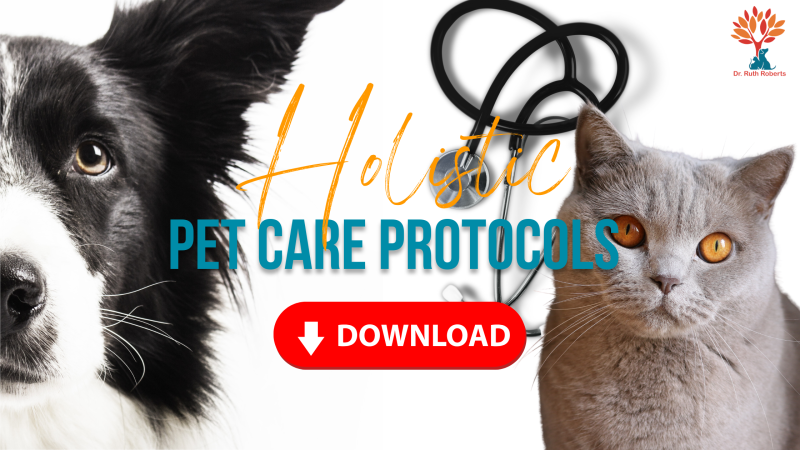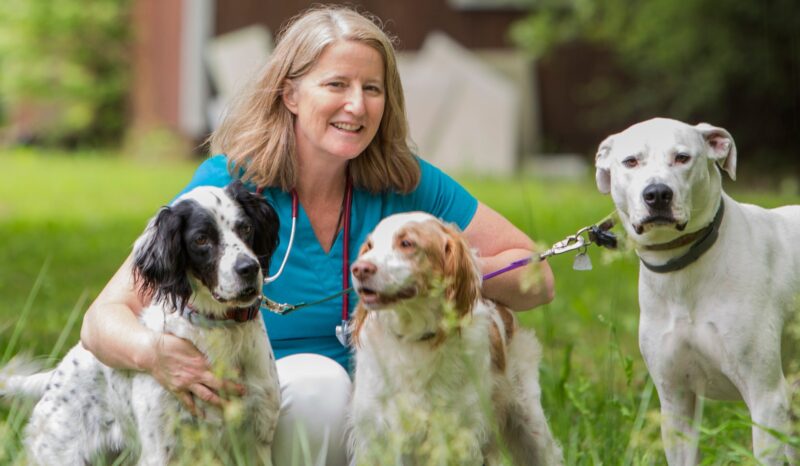Ways To Prolonged Your Pet's Longevity
Step into a captivating conversation with Dr. Ruth Roberts as she takes the spotlight on Dr. Stephanie Grey’s podcast. In the first of a two-part series, Dr. Roberts reveal the secrets to maximizing our pets’ longevity. She explores the strategic timing of spaying and neutering, or even considering alternatives. Additionally, discover the transformative power of a whole food diet, brimming with nutrient-rich vegetables and fiber, all expertly prepared in The Original CrockPet Diet. Tune in for a journey into holistic pet care that promises to enrich and extend the lives of our beloved companions
Intro
Dr. Stephanie Gray: Welcome to The Your Longevity Blueprint podcast. I’m your host, Dr. Stephanie gray. My number one goal with the show is to help you discover your personalized plan to build your dream health and live a longer, happier, truly healthier life. You’re about to hear from Dr. Ruth Roberts. Today she’s going to talk about how longevity in pets can be increased by spaying and neutering later or not at all, and how feeding a whole food diet that is high in vegetables and fiber can be made in a Crockpot. This is part one of a two part series in part two, we’ll dive into what vaccinations, flea tick and heartworm medications are actually necessary and which are not. This interview is a blast. Let’s get started.
(Intro music)
Dr. Stephanie Gray: Welcome to another episode of The Your Longevity Blueprint podcast. today. My guest is Dr. Ruth Roberts, who has supported 1000s of dogs and cats to overcome health hurdles like kidney disease, GI illness, allergies and cancer. Her natural approach to healing creates a gentle yet effective path for your pet to take on their journey to well being. Dr. Ruth created the original Crockpet Diet, a balanced home cooked diet for pets as the foundation of Health. Dr. Ruth will help you develop a health plan for your pet via elearning videos on a range of health topics and one on one coaching. Welcome to the show, Dr. Roberts and whoever you have with you here
Dr. Ruth Roberts: This is Hiyo. Thanks very much, Dr. Stephanie Gray. It’s such a pleasure to be with you.
[1:40]
Dr. Stephanie Gray: Well tell us your story. How did you become as they call you, I know you say on your website, your pets ally and kind of learn to blend functional medicine methods for the caring of animals.
Dr. Ruth Roberts: Like a lot of doctors, it took me getting sick and realizing that there just weren’t good options. I was very fortunate to find a functional medicine practitioner in South Carolina where I was living at the time. And the help that he was able to give me was just unbelievable, because I’d seen so many of my own clients come in with IBS, with Fibromyalgia, things like that. And it was horrible, because I watched so many of them be turned into junkies. So they started on NSAIDs, and then they got pushed up and up and up into narcotics. And I knew I did not want to go that route. So I was really really fortunate to find find this doc. And that made me open my eyes and realize that if it’s working for me, if simple things like changing your nutrition, eliminating certain things from your diet would had such a profound effect for me, what would it do for pets. And interestingly, at the same time, I’d started studying acupuncture at the Chi Institute in Redick Florida, I had a dog that had bacterial endocarditis, and yeah, and that’s pretty ugly stuff. Most dogs unfortunately die from it. Thankfully, she sort of, she got through it. And it was sort of not as severe cases, some other pets, but what they told me is Okay, start cooking for her and use these herbal formulas do these acupoints. Well, she had wanted nothing to do with acupuncture. But she thought the idea of home cooking was fantastic. She took the herbs, we went through conventional therapy as well. And she contracted this at nine and live to be 13. So I mean, that’s just crazy. Amazing. But that’s what convinced me we really have to start with the basics with pets.
Dr. Stephanie Gray: So you are having your own health challenges when you are already a vet. And then you kind of apply them to animals, your animal in particular and then.
Dr. Ruth Roberts: Exactly, exactly. And that’s exactly it. So I started out trying to fight my way back out of fibromyalgia. And the more I learned, the more I’m thinking this is stupid. Why am I not doing this for animals? That’s exactly it, to learn how to translate it to help dogs and cats.
[5:35]
Dr. Stephanie Gray: And that’s really why I’m so excited about this interview because I also kind of felt stupid like, Well, gosh, I’m earning my living by helping other patients rebuild their health, but yet I have this dog at home who’s probably eating crappy food. And I’m not really applying any of those principles to her. And so I was just excited to meet you and obviously excited for this conversation. So let’s talk about food. Let’s go there. I’ve had other veterinarians on the show, and they’ve given great information to our listeners. And I know there’s some debate on what the best food is for animals. But I think all the vets I’ve talked to agree that kibble is not the best right? It’s processed it’s just crap. Can you expand on that so let’s talk about what’s not good food and then you we can expand on to what you think good food,
Dr. Ruth Roberts: You right, and that’s essentially it. I mean, with kibble essentially we’re feeding our pets Doritos and beef jerky sticks. I mean, that’s the quality of the of the foodstuffs going in there. I take many of my holistic colleagues are all about raw food, and because I was trained into Traditional Chinese Medicine, I learned that cooked food is better because it helps sort of present the digestive system with pre digested food. And so something that’s going to be easy for the animal for the person to further digest and assimilate. So the argument is, is that raw food is the ancestral diet of dogs. And I would argue that it is, but it’s also our ancestral diet. And I don’t think many of us would do well eating raw meat all the time. I think there’s pretty clear evidence now that dogs Canis familiaris, diverged from wolves with Qeynos, something like 40,000, just guessing that backwards Canis lupus, something like 40,000 years ago, what happened is, is that they evolved with us Homo sapiens. And so first, they’re eating our garbage, then they’re eating our leftovers. And then finally, what we fed them. And as our diet has evolved so rapidly, since the 50s, really 1950s, theirs has as well, and we’ve all gone from pretty much a whole foods diet, that would be based on what’s available in the region where we’re located, and into this highly processed ship 1000s of miles, just mess that we’re currently in. For that reason, I really think that if we back it up several steps, and start cooking for our pets, again, in a balanced ratio. So roughly 1/3 protein 1/3 fat, healthy fats, 1/3 carbohydrates, both vegetables, and other simple carbohydrates, that really is the best way to achieve health for pets.
Dr. Stephanie Gray: Can you say that again? You said 1/3, protein, 1/3, fat
Dr. Ruth Roberts: 1/3, healthy fats and then 1/3 carbohydrates. So basically, it’s the Whole Foods nutrition approach.
Dr. Stephanie Gray: And how would that compare to kibble?
Dr. Ruth Roberts: Kibble is roughly 65 to 80% carbohydrate, and sadly, it’s all highly processed. So it’s like, boom, sugar.
Dr. Stephanie Gray: So is that why our dogs and cats are getting diabetes and other chronic diseases? I mean, is that one of the main Do you feel like reasons?
[8:44]
Dr. Ruth Roberts: It’s one of the big reasons. And here’s the really sad thing in our effort to and this is a segue away from food. But we’ll come back to how we can fix this issue. The problem is actually spaying and neutering because we are removing their gonads at six months. So I used to think, oh, it’s because they’re never allowed to become endocrine competent, their systems never develop, it turns out, so the more recent research actually is that the amount of luteinizing hormone that is produced in their bodies is something like 20 to 30 times what it would be in an intact of dog or cat. And what happens worse is that all of these tissues that shouldn’t have receptors for luteinizing, hormone, grow receptors, and they’re in the brain, the gut, the joints, the immune system. And so this really is the proposed mechanism for why there is such an epidemic of chronic disease in our pets. And then if you throw a horrible, highly processed pro-inflammatory diet, on top of that, it’s just a recipe for disaster.
Dr. Stephanie Gray: I want to unpack a lot of that. So let’s, let’s go to the surgery. Oh, we will come back to food. But since we went on that tangent, when I met you, that was kind of one of my concerns that I guess, and regrets that I have with my mini goldendoodle, we got a puppy right before I met my husband, I became pregnant and it was our first child and our vet kind of pressured us into, you’re going to be overwhelmed with your first baby and might as well just get your dog, you know, fixed now and not have to worry about it after the baby’s here. And I thought, no, hang on here. If I have female patients who go through surgical menopause early in life, they’re at greater risk of heart disease of bone loss of memory loss, we’ll just say a mood and impacts on mood and just overall well being. And so I’m thinking, what’s the impact on my dog? And my I said, can I delay the surgery and my dog kind of said, My dog, my vet said, you don’t want your dog going into here. You don’t want to deal with all that. And she didn’t have a lot of input. And now I know my intuition was right. So next time around, I’m going to delay the surgery. But let’s stay on this topic. So what is the solution? And like how can we best delay these sorts of surgeries?
Dr. Stephanie Gray: But let’s stay on this topic. So what is the solution? And like how can we best delay these sorts of surgeries?
Dr. Ruth Roberts: A lot of it is you being your pet advocate and saying thanks so much for the information. But I’m going to wait for a little longer because I’ve read this and this and this and frankly University of California Davis started doing started publishing research papers in 2013 showing that there was a link between increased disease of all sorts in pets that are spayed and neutered versus pets that are not and they started with the golden retriever study and then the golden retriever Labrador study and then since then, they’ve been just doing a massive review of all of their patient records and looking you know what happens to the endocrine system what happens with other pets? And those two breeds, Golden’s and Labs have far more disposition to these horrible diseases. But it’s the same for all pets.
Dr. Stephanie Gray: But I’m pretty sure, I was told the latter I’m pretty sure I was told “oh, by having this surgery performed on your animal, they’ll have reduced risk five isn’t mammary cancer or
Dr. Ruth Roberts: Yep, mammary cancer and breast cancer, and then they have increased risk of come angiosarcoma, lymphosarcoma, osteosarcoma, all of these really awful cancers.
Dr. Stephanie Gray: And are those more common than mammary cancer? I mean, if we really break it down, like are those more aggressive? It sounds like are they more–
Dr. Ruth Roberts: Oh it’s horrible. It’s horrible. And I am old enough when I started practice in 1990, 90% of pets were intact. I would rather treat mammary cancer or prostate cancer in males all day long than him angiosarcoma lymphosarcoma, these horrible, horrible cancers.
[13:36]
Dr. Stephanie Gray: Good to know. So we need to be our pets advocate. How long should we delay, like, for the endocrine system, I guess, get the benefits of the hormones. And how long do we wait,
Dr. Ruth Roberts: Ideally, at least until five, because that’s going to be roughly equivalent to when we as humans would go through menopause and andropause. There’s a guy that did the old gray Mazal tour. And he looked at Rottweilers that were 13 and 14, and 15, which is incredibly unusual. None of them were spayed or neutered, and they died with cancer, not of cancer. Does that make sense? So his recommendation is five or why, you know, unless there’s a medical reason to spay or neuter, don’t.
Dr. Stephanie Gray: So then I don’t know a lot about this, but like so does a female dog. How frequently would a female dog go into heat in those five years? Is it like twice a year, I don’t even know.
Dr. Ruth Roberts: Well, and this is the other thing, that’s weird. It used to be twice a year, and then it got to be once a year. And they got to be older and older before they would go into heat. And I think that is related to the pro inflammatory diet. It’s something you just have to deal with. That’s kind of like having a moody teenager for about three weeks, and then it’s over. But you know, we’ve lived with dogs for 1000s of years that were intact before we started spaying and neutering everybody. So we got used to it. We taught our dogs manners, for lack of a better description about how to behave around each other with being intact dogs, but it’s very difficult in this day and age, sadly,
Dr. Stephanie Gray: My brain is literally thinking okay, so if I do this for my next dog, and I want to take them to doggy daycare, they just can’t go during that month, you just avoid, because you can’t really monitor like I can help my with my dog’s behaviors if we’re out on a walk, but if I drop them off at doggy daycare, yeah, so just avoid those
Dr. Ruth Roberts: Right. And the other problem is this is that for many of the daycares, and the boarding kennels, they won’t accept dogs that are intact because their insurance policies prohibit them from doing so,
Dr. Stephanie Gray: Have to get a dog sitter. There’s an alternative.
Dr. Ruth Roberts: It’s the best option. Yeah, group mommy daycare,
[15:41]
Dr. Stephanie Gray: Great information. Let’s go back to what you feel is the best food literally whole food in your Crockpet Diet. So let’s Can you break that down and kind of explain what that is.
Dr. Ruth Roberts: So The Original Crockpet Diet was essentially a variation on some recipes that my professors at the Chi Institute taught me and as I learned more and more incorporated different food sources, but essentially what it is is a lean cut of protein. So the least expensive are typically pork, beef, and then turkey or chicken, if your pets not sensitive and unfortunately many are and then healthy fats. So things like avocado oil, grapeseed oil, healthy vegetable oils that are processed correctly, and then lots and lots and lots of veggies. So things like brassica species, broccoli, kale, cabbage, other veggies and then I am a big proponent of using beans because they are essentially slow carbs. So meaning that the fiber prevents that big head of sugar from being absorbed and then using grains as well. So rice is a quinoa, things like amaranth things of that nature. And then the more kind of standard issue ones of oats and things like things like that rice so essentially that’s it it’s very simple to make the ideas you put it all in a slow cooker or if you don’t have one you would use roasting pan in the oven. big stock pot on top of the stove. Whatever is easiest for you to do.
Dr. Stephanie Gray: And you have a video I watched it the other day of you literally you preparing this entire thing chopping your vegetables, putting everything into the pan and cooking it and then afterwards I noticed you have your what’s it called when you mix up the food the oh the immersion blender immersion blender. Yeah, so you basically broke it all down and that’s just that so they just won’t choke. So the animal–
Dr. Ruth Roberts: Well, yes, sadly, actually we had a Dachshund that that just was such a pig. She would inhale her food and so we had to puree it into a pate for her because she would show herself out a couple of times, Sir, our cat Pepe would happily eat it as is little mixing Hyio our little poodle that’s with us now has no tea. So for her it’s necessary the period.
[17:50]
Dr. Stephanie Gray: So I noticed there’s some other additives. So you put in turmeric and mustard and even some salt, some calcium, garlic, can you speak to some of those.
Dr. Ruth Roberts: So the calcium is necessary to balance the diet so that the calcium phosphorus ratio was correct in the protein, the salt is there to actually increase the chloride level. We had kelp for iodine, and then the culinary herbs of turmeric mustard, and one clove of garlic, which usually freaks people out.
Dr. Stephanie Gray: It freaks me out, because I ran away and thought, wait a minute here what I thought I’m sick.
Dr. Ruth Roberts: And yeah, so it is toxic, but it’s also toxic to us. And so for frame of reference, a 50 pound dog can eat one clove of raw garlic every day without a problem. So one clove of cooked garlic in 16 cups of food, not a big deal. The reason those herbs and spices are there is because in Chinese medicine, they help to move things, they help resolve stagnation and stagnation in Chinese medicine is what causes pain, cancer, stiffness, you know, so it helps it’s more of a preventive strategy or a long term strategy.
Dr. Stephanie Gray: So you basically make a big, huge batch. And then I saw you have these silicone bags where you essentially are freezing some of it, how do you heat that up
Dr. Ruth Roberts: Make it super easy. So basically, what you would want to do is have no more than about five days worth of food in the refrigerator so that it doesn’t go bad and give your dog food poisoning or your cat and freeze the rest. And then what we do for our guys is take a measuring cup and scoop out what they need for that meal. And then we’ll add some more water to it to warm it up and take the heat off of it.
[19:32]
Dr. Stephanie Gray: So you basically have on your guide here, you know if you’re using pork or beef or turkey with or without beans, like just exactly how many tablespoons whatnot, is a serving? And I know this is more of a complex question. But I did have one follower asked for different breeds like working breeds versus hunting dogs versus like a dog that sleeps all day to certain breeds need more protein or for the most part is this kind of ratio of the third protein to a third fat to a third carbs is that pretty appropriate? Regardless,
Dr. Ruth Roberts: It’s pretty appropriate regardless, I will say so one of our one of my long lost buddies, Esau was an English senator, and that guy would run sunup to sundown, so he needed more fuel. So what we did is we kept the same volume of the food as far as the 1/3 1/3 1/3, protein, fat and carbohydrate, but we added extra fat and extra carbohydrates to his each meal to keep his weight up. So I think there’s beginning to be some pushback, even on the human side, as far as eating too much protein causes more inflammation. And so I think the other issue is sustainability. Cats and Dogs already eat 25 to 30% of the conventionally produced animal proteins in the United States. So trying to push them all to raw is like going to be a problem. And I think that even now people are having difficulty getting certain types of proteins with consistency in the grocery store. It’s really important to be environmentally sustainable with our pets.
[21:02]
Dr. Stephanie Gray: So how do we transition an animal to this? Like, I kind of feel like well, my I already give my dog table scraps which that’s another question. Should I or should I not doing that? I know from a behavior standpoint, it’s not nice when you have company for your doctor back at the table. But sometimes if we have a roast, I feel like that’s good meat. I’ll give her a little bite. Is that okay?
Dr. Ruth Roberts: Absolutely. And to avoid the behavior issue of begging, just it stays on your plate and goes directly into her bowl and the bowl goes down on the floor. So that way Don’t wait.
Dr. Stephanie Gray: Yeah. So how do we transition animals to this because I feel like this is more doable than raw food. I just feel like it’s easier as well. And I understand it sounds like the digestive system has their digestive systems have adapted in that this would be easier on them anyways, that’s that’s what you’re saying so, so I cook a big batch, am I going to you know, still give her if what her serving was going to be am I going to give her half of that with half of her dry food for a while or–
Dr. Ruth Roberts: It depends. So if your pet has ever had any GI issues, I’d start really slow. So start with 75% of what she’s currently eating 25% new and plan to take two weeks to transition over
Dr. Stephanie Gray: like in the same bowl at the same time. Just put it all in there and let her and–
Dr. Ruth Roberts: How much to start with. So kind of figure out what the current volume is that you’re feeding. So if you’re feeding two cups twice a day, then basically you would start with a cup and a half of what you’re currently feeding and then a half a cup of crock that died. Once you get your pet transitioned all the way over to cooked food to the Crockpet Diet then start to look okay, is she doing okay as far as maintaining weight? Is she losing too much weight? What do we need to do to make sure or that she stays at a good healthy body weight and maintains plenty of muscle.
Dr. Stephanie Gray: So eventually you just make that transition over and then they most animals to your experience do fine.
Dr. Ruth Roberts: They do fine. The only time there’s an issue is when an owner is like, okay, Kibble’s out let’s feed Crockpot, boom, that can create some real problems, some diarrhea and GI issues.
[25:18]
Dr. Stephanie Gray: Now, when I think of like foundational nutrition, obviously, for humans, that’s also real foods, not processed food, but I’m recommending for my human patients, right multivitamin fish oil, vitamin D, probiotics, various supplements, sometimes other anti inflammatories or whatnot. So do animals need these as well? And is this kind of where your Holistic Total Body Support comes in? Can you speak to that?
Dr. Ruth Roberts: Absolutely. You know, the same issue, the reason you’re asking your patients to take supplements is that the quality of the nutrients that are available in our food just isn’t the same as it used to be because of the current farming practices. So to make sure that the diet stays balanced, it’s important to use some sort of a supplement the things that tends to be most lacking in many of the easy to find dog supplements on Amazon especially are going to be things like zinc, vitamin D tends to be a wee bit low, and then choline and vitamin E, especially it’s easy and inexpensive to get the B vitamins squared away, but these other critical nutrients are often left out. Sadly, the other thing is, too with holistic total body support is it contains a lot of glandular materials, which is part of how I help address the problem we were talking about earlier, the side effects basically of spaying and neutering.
Dr. Stephanie Gray: For listeners, what she’s saying is, is giving these animals the glands to support their glands, essentially.
Dr. Ruth Roberts: Exactly. Feed their endocrine system, and then the same list of nutrients. So omega 3 fatty acids are going to be super important to add in. And then we add other supplements based on what health conditions that pet might be experiencing. They have a terrific amount of inflammation going on. Omega threes helped tremendously, but we might add some turmeric, we might add some ginger, we might add queer sweetener, actually,
[27:01]
Dr. Stephanie Gray: I’m glad you said that. But let me before we go to those, let me come back to Holistic Total Body Support. So for someone who hasn’t converted over to the Crockpet Diet yet, like me, right, you gave me some of that to try on my animal, you can sprinkle it over the kibble mill, the scoop whatnot, or if the animal won’t eat it that way, how else like would you just give it was some sort of snack or treat or peanut butter or something like
Dr. Ruth Roberts: You could do that. And the other thing is, too is that it seems daunting at first to start cooking for your pet. But if you do nothing else, then go out and buy a bag of frozen Normandy blend vegetables. So essentially some yellow squash broccoli, cauliflower, I think that’s what’s in that mix and take a quarter cup, boil it up with some water to cook it through, put that on top of your pets food and mix the supplement in with that it will disappear pretty quickly.
Dr. Stephanie Gray: Start with the vegetables. And so certainly you can give your dog the– or cat, your animal, the holistic. Well, let me clarify it. This is for dogs and cats.
Dr. Ruth Roberts: It is for dogs and cats. It is the only supplement on the market that has enough touring for cats, and actually enough taurine for breeds that are predisposed to heart disease.
[28:07]
Dr. Stephanie Gray: So let’s go back to those other supplements because there was actually a post on Facebook a while ago someone asking what do I get my dog to support their joints and shy of me just referring them to you I said, Well fish oil, you can give your dog you know, omega is about how much
Dr. Ruth Roberts: Minimum dose so minimum dose to balance the Omega-3 to six ratio just so the Omega-6 are the pro-inflammatory ones, the omega-3 are the anti-inflammatory and that’s the gross, simple oversimplification. But to get them into balance, you would give 100 milligrams per pound of body weight of omega three fatty acids. And then the doses and actually this is one of the few places where veterinary medicine has done some research and then for dogs that have arthritis, for instance, yeah, the dose there is almost 300 milligrams per pound of body weight. So it’s a pretty massive dose.
[28:59]
Dr. Stephanie Gray: What about turmeric? Turmeric
Dr. Ruth Roberts: It’s really, here’s what’s really interesting though, recently, so turmeric, you can give anywhere from around 20 milligrams of curcumin, especially for your average 50 pound dog. What I’ve been finding recently those that a lot of dogs actually have gi sensitivity to turmeric, because everybody’s using it in everything. Like it’s an every supplement of the world right now. So what a lot of people have been finding relief with is is actually quercetin.
Dr. Stephanie Gray: Awesome. Yeah, that’s wonderful. So how do we do that though?
Dr. Ruth Roberts: Actually, if you head over the website, there’s a product I have called Hista Pawz. And the dosing chart is there but in a nutshell, for 25 pounds and less, you’d be somewhere around 75 milligrams per day and then it sort of escalates up from there. It can have some GI upset but that’s pretty infrequent.
Dr. Stephanie Gray: Of course and I think this, these last few years of all years are spent finally gaining some, some hype, and that it’s certain It supports our immune system it’s a zinc and for control zinc into the cells antioxidant. Great for allergies I think as you were alluding to is just wonderful.
[30:06]
Dr. Stephanie Gray: On the topic of nutrition and nutritional deficiency, I have a question about my dog liking to chew grass, is that just something she’s doing to soothe her potentially upsetted, upset stomach? Or is she just playing? She’s just, she’s always eaten grass.
Dr. Ruth Roberts: Like why I think there’s there’s a myriad of reasons and so one is, you know, she’s getting some minerals and things of that nature out of the grass. The other is she could have an upset stomach. I mean, that’s sort of the standard issue answer. And then interestingly, there’s a product called Fidospore made by a MegaSporeBiotic folks. It includes PD a caucus, which is an organism found on grass, it’s my probiotic organism found on grass so she may be trying to inoculate her gut with something that will be helpful but I think for many many pets it really is to help get some fresh green into their diet and to balance add in some more minerals and nutrients.
Dr. Stephanie Gray: Awesome and all these products are on your website and will direct listeners to the conclusion of the episode.
So much information right there. I definitely don’t want to feed my dog Doritos and jerky I need to start this crock pet diet and Dr. Roberts has all the info I need to help hop on over to the link we’ll post in the show notes for her free download when not to go to the ER which is pretty cool, and even has a list of what you need to make your own home first aid kit with and you can use referral code Dr. Stephanie gray to get 10% off every purchase of The Original Crockpet Diet and 10% off anything in her shop using the link again we’ll post in the show notes. Be sure to tune in next week where we’ll dive into vaccines, flea tick and heartworm medications. See you then be sure to check out my book your longevity blueprint. And if you aren’t much of a reader, you’re in luck, you can now take my course online where I walk you through each chapter in the book. Plus for a limited time the course is 50% off, check this offer out at your longevity blueprint.com and click the Course tab. One of the biggest things you can do to support the show and help us reach more listeners is to subscribe to the show. Leave us a rating and review on Apple podcasts or wherever you listen. I do read all the reviews and would truly love to hear your suggestions for show topics guests and for how you’re applying what you learn on the show to create your own longevity blueprint. This podcast is produced by Team podcast thank you so much for listening and remember, wellness is waiting the information provided in this podcast is educational no information provided should be considered to be or used as a substitute for medical advice, diagnosis or treatment. Always consult with your personal medical authority.
Key Takeaway
Removing the gonads at a young age disrupts the endocrine system, leading to an overproduction of luteinizing hormone and the growth of receptors in various tissues. This phenomenon is believed to contribute to the epidemic of chronic diseases in pets. Dr. Roberts suggests that early spaying/neutering and a poor diet exacerbate the problem.
Spayed/neutered dogs have an increased risk of various cancers, including mammary, angiosarcoma, lymphosarcoma, and osteosarcoma. She mentions her preference for treating mammary or prostate cancer over these aggressive forms of cancer.
Proactive advocate for pets and delaying spaying/neutering until at least five years of age, equivalent to when humans experience menopause.
Dr. Roberts suggests alternatives such as hiring a dog sitter or finding a daycare accommodating intact dogs. The discussion emphasizes the importance of being informed and making individualized decisions regarding spaying and neutering dogs if the.
CrockPet Diet is a homemade pet food that consists of lean cuts of protein such as pork, beef, turkey, or chicken (if the pet is not sensitive to it), healthy fats like avocado oil or grapeseed oil, a variety of vegetables including broccoli, kale, cabbage, and beans as slow carbs. Grains like rice, quinoa, amaranth, and oats are also included. The ingredients are typically cooked in a slow cooker, roasting pan, or stockpot.
Recommends adding certain additives to balance the diet. Calcium is necessary to maintain the correct calcium-phosphorus ratio in the protein. Salt is added to increase the chloride level. Other additives include kelp for iodine and culinary herbs like turmeric and mustard. Dr. Roberts also mentions using one clove of garlic, which is controversial due to its potential toxicity but is considered safe in small amounts.
To store the homemade pet food, Dr. Roberts suggests keeping no more than five days’ worth of food in the refrigerator and freezing the rest. When serving, the frozen food can be thawed and warmed up with some water added.
The recommended nutritional ratio in the CrockPet Diet is one-third protein, one-third fat, and one-third carbohydrates. While different breeds and activity levels may require adjustments in the amount of fat and carbohydrates, the overall ratio remains the same.
When transitioning a pet to the CrockPet Diet, it is advised to start slowly, especially if the pet has a history of gastrointestinal issues. Gradually replace a portion of their food with the CrockPet Diet over two weeks. Monitor the pet’s weight and adjust the amount as needed to maintain healthy body weight and muscle mass.

